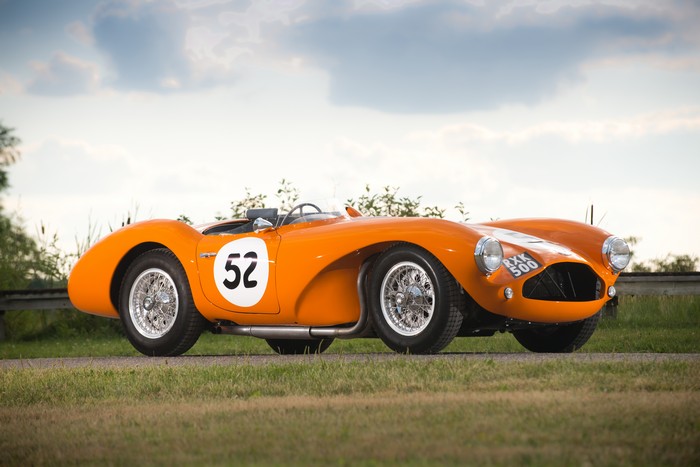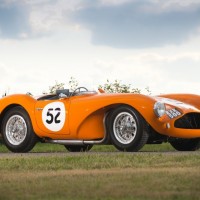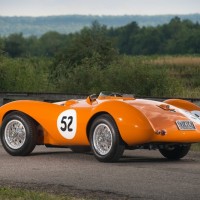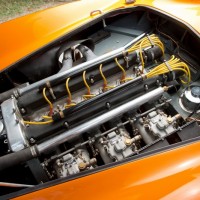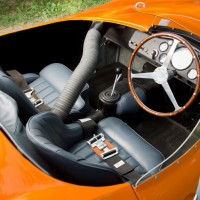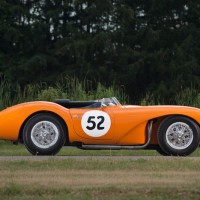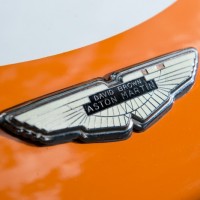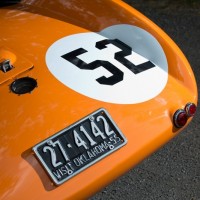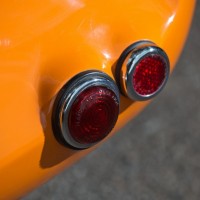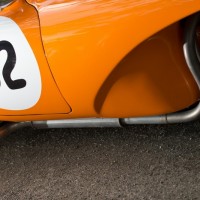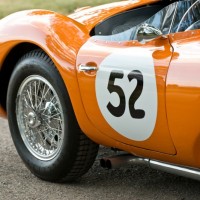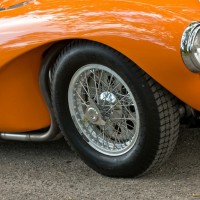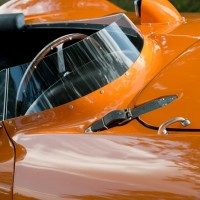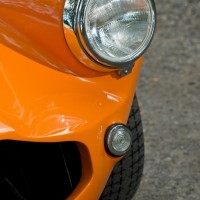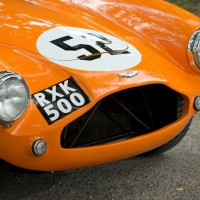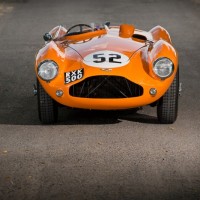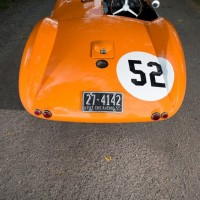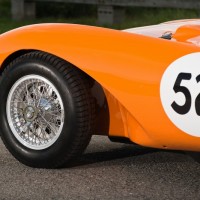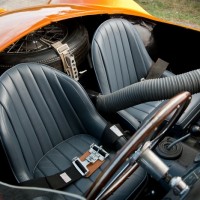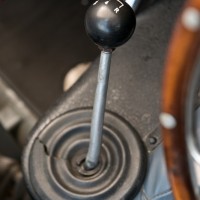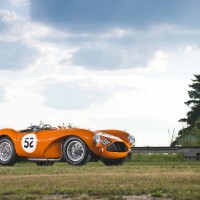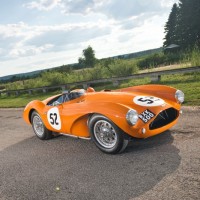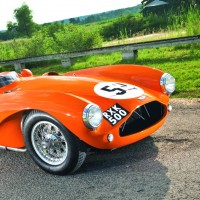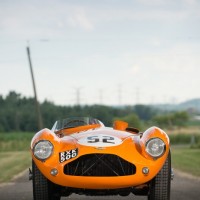SCM Analysis
Detailing
| Vehicle: | 1955 Aston Martin DB3S Sports Racer |
| Number Produced: | 31 |
| Original List Price: | Unknown |
| Engine Number Location: | Rear of engine block |
| Club Info: | Aston Martin Owners Club |
| Website: | http://www.amoc.org |
This car, Lot 214, sold for $3,685,000, including buyer’s premium, at RM’s Monterey auction on August 18, 2012.
The most important thing to learn about the Aston Martin DB3S is that it is not what you — or at least people who have never driven one — expect it to be, and that is the surprise, the amazement and the joy of these cars.
The genre of “early to mid-’50s sports racing cars” is pretty much defined by the Jaguars, Ferraris, Allards and Talbot-Lagos that filled most of the grids in those days. They tended to be big and relatively heavy — or certainly feel that way — with steering that was more secure than light or responsive. This was appropriate to the era, as the venues were more often public roads than dedicated tracks, with all of the cracks, potholes and sharp edges that general-usage paving is subject to, and the races were long — a hundred-miler was considered a sprint. To win, you had to finish with both car and driver operational, so the cars were built to err on the side of strength and the drivers’ experience (insofar as it was considered at all) tended toward a certain numbness to prevent them from getting used up in the first few hours.
The time of light, supple, responsive racing cars was years in the future — for the most part.
Slow and ugly — at first
Aston Martin had been a small niche marketer since 1913, but with limited success. They had built roughly 700 cars when World War II began and fell into liquidation shortly after it ended.
David Brown was a successful industrialist with a commensurate ego and a love for racing, and he bought the company along with the also-bankrupt Lagonda in 1947. Brown combined Aston Martin’s automobile production abilities with Lagonda’s engineering expertise (particularly a W.O. Bentley-designed 6-cylinder engine design) and began producing the now-famous DB (go ahead, guess where that came from) series of Aston Martins.
The DB2s and their successive variants were fundamentally sporting road cars and were very successful in competition into the early 1950s, but Brown felt the need to build a purpose-built competition car. So, in 1952, Aston Martin introduced the DB3. It was ugly, clumsy, not particularly fast, and unreliable to boot: not what Brown had in mind.
At this point, Brown brought in Bill Watson to more or less start over, and the result was the DB3S, which was first seen in May of 1953. It immediately proved to be a match for Jaguar’s C-type on the track, but for whatever reasons, it never achieved the notoriety and recognition of the Jaguar.
It could have been production: Aston built 11 “factory team” cars and 20 “customer” DB3S cars, while Jaguar built 53 C-types and introduced the D-type during this period, so Jaguar was far more ubiquitous. Race entries show lists of Jaguars but seldom more than one or two Astons for any given event.
The Aston was also far more exclusive. I’ve been unable to find a list price for a DB3S, but it was certainly far in excess of the £1,500 that Jaguar asked for their C-type, and Aston never really flogged these cars on the market — you had to be somebody to buy a DB3S.
The result is that most people don’t know much about the DB3S, and those that do tend to think that they are sort of a C-type by Aston Martin. Nothing could be further from reality. Although the two cars are directly equivalent on paper, they have intensely different personalities and “feel.”
A quick story may illustrate this:
This spring, my company had a track day to check out a number of client cars before the racing season began, and the list included an Allard J2X, a Jaguar C-type, and a DB3S. The chief test driver was extremely experienced and professional, with well over 100 racers on his list of cars driven on the track, from Sprites to ground-effects F1 cars, but he had never driven an Aston.
The format was set; one out lap, three hot laps, then come in to discuss what we’ve learned (my foot was in a cast, so I could only watch). The Allard went first, thundering down the straight and slewing through the corners, and the comments were: “Wow! Well, it actually works better than I expected.”
The Jag was next, with the comments that it was “sweet, solid and predictable, but pretty soft and inclined to wallow in the twisty bits.” Then the Aston went out, and when it came in, the tester was laughing and hooting through his face shield and pounding on his knees in exhilaration — literally. The Aston is that much fun to drive.
A handling dream
The first time I drove a DB3S, it felt like I had stepped out of a Big Healy into a Lotus: It seems absolutely tiny after something like a C-type, and feels incredibly light and flickable — to the point that it seems insecure at first, but you quickly get used to it. On the track, it turns in easily, then with application of power, the rear steps out 10 to 15 degrees, and with a little steering correction, stays there as the car simply flows through the corner and onto the next straight. This car makes even a mediocre driver feel like a young Stirling Moss.
For me, this car is simply the best mid-’50s sports racer that exists, but they remain almost completely unknown in a world that reveres Jags and Ferraris.
However, they are not undervalued. For years now, DB3S values have tracked almost exactly with C-types (which, by the way, are always valued in £ Sterling, not dollars or euro). This substantially broadens the comparables base, as there always seem to be C-types on the market. Currently, the value range seems to be from £2.4 million ($3.8 million) or so for a good-but-unexceptional example to well over £3.3 million ($5.4 million) for an important team car.
This suggests that our subject car was sold at the bottom of the range, and I agree that this is the case. Much of it, I think, had to do with presentation: It may originally have been orange with blue seats, but it was not an attractive color on a car being sold at auction. The car generally felt too bright, too crisp, and too new to bring top dollar. These cars sell best when they have a bit of a scruffy patina, so they feel authentic to the buyer. However, this was an excellent car, and they are fabulously fun to drive. I would say well bought.
(Introductory description courtesy of RM Auctions.)
